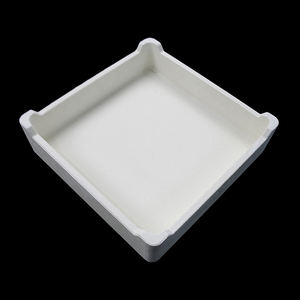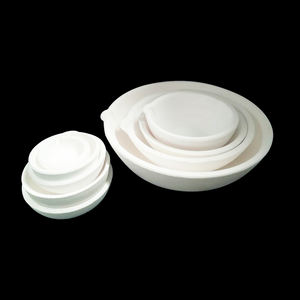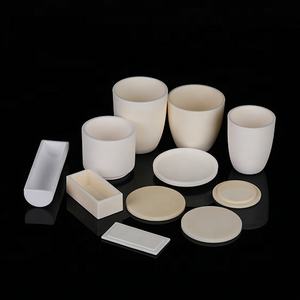Professional industry ceramic supplier, silicon nitride, silicon carbide, aluminum nitride and any other kinds of ceramics.
PRODUCT PARAMETERS
Description
Overview of Factory Direct Melting Furnace Crucible Ceramic Crucible / Quartz Crucible
Factory Direct Melting Furnace Crucible Ceramic Crucible / Quartz Crucible are a unique class of materials manufactured by fusing high-purity quartz crystal into a non-crystalline, vitrified form. This process results in a ceramic with an exceptionally low and predictable thermal expansion coefficient, making it supremely resistant to thermal shock. Its outstanding optical, thermal, and electrical properties make it indispensable in high-temperature viewing windows, semiconductor processing, precision instrumentation, and aerospace applications.
Features of Factory Direct Melting Furnace Crucible Ceramic Crucible / Quartz Crucible
-
Exceptional Thermal Shock Resistance: Its near-zero thermal expansion coefficient allows it to withstand extreme and rapid temperature changes without cracking.
-
High Purity & Chemical Stability: Excellent resistance to corrosion from acids and molten metals, ensuring performance in aggressive environments.
-
High Service Temperature: Can be used continuously at high temperatures while maintaining its structural integrity.
-
Excellent Optical Properties: Offers high transmission from the ultraviolet to the infrared spectrum, ideal for lenses, windows, and optical substrates.
-
Low Thermal Conductivity: Provides effective thermal insulation.
-
Superior Electrical Insulation: Maintains high electrical resistivity and low dielectric loss at elevated temperatures.
Specifications of Factory Direct Melting Furnace Crucible Ceramic Crucible / Quartz Crucible
Here’s the product content about factory direct melting furnace crucibles:
These crucibles hold molten material inside your melting furnace. We make ceramic and quartz types. Both go straight from our factory to you. This means better prices for you. You also get them faster.
The ceramic crucibles use strong alumina material. This material handles very hot melts well. It works for melting metals like gold, silver, or copper. It also works for alloys. These crucibles resist chemical reactions. This keeps your melt pure. They handle thermal shock decently. Thermal shock is quick temperature changes. Good density stops leaks. They come in many sizes. Small sizes suit jewelry work. Big sizes handle larger batches. Expect long service life with proper care.
Quartz crucibles are different. They are made from pure fused silica. This gives excellent clarity. You see the melt clearly. Quartz handles even higher temperatures than alumina ceramic. It is perfect for very high heat jobs. This includes silicon or special glasses. Quartz is super pure. It adds almost nothing to your melt. This is vital for sensitive materials. It resists acids very well. But, avoid strong alkalis. Quartz also handles quick heating and cooling very well. Like the ceramic ones, many sizes exist.
Both crucible types share good points. They resist wear from the melt. They last long under normal use. Our factory controls quality tightly. We check every crucible. We offer standard sizes ready to ship. Need something special? We make custom shapes and sizes too. Just ask us about custom options. Thick walls provide strength and safety. Smooth inside surfaces make cleaning easy. Good heat transfer helps melting happen faster.
Applications of Factory Direct Melting Furnace Crucible Ceramic Crucible / Quartz Crucible
Factory direct melting furnace crucibles get materials very hot. Ceramic crucibles and quartz crucibles are the main types. People use them a lot. Ceramic crucibles are tough. They handle high heat well. Factories use them for melting metals. Metals like aluminum, brass, bronze, and copper are common. Ceramic crucibles resist chemical reactions. This keeps the melted metal clean. They are good for foundry work. Jewelers also use smaller ceramic crucibles. They melt gold and silver. The crucibles last many heats. This saves money.
Quartz crucibles are different. They are made from very pure silica. Quartz stays stable at extreme temperatures. It is great for melting very hot materials. People use quartz crucibles for silicon metal. The semiconductor industry needs pure silicon. Quartz crucibles help make solar cells. They are also used in labs. Scientists melt special glasses and oxides in them. Quartz doesn’t add impurities. This is important for exact results. But quartz is more fragile than ceramic. You must handle it carefully.
Buying these crucibles factory direct makes sense. It cuts out the middleman. You get a better price. You also get the crucible faster. Factories know their products best. They can offer good advice. You get the right crucible for your job. Both ceramic and quartz crucibles are essential tools. They handle tough jobs reliably. Getting them direct improves your process.
Company Profile
Tanki New Materials Co.Ltd. focus on the research and development, production and sales of ceramic products, serving the electronics, ceramics, chemical and other industries. Since its establishment in 2015, the company has been committed to providing customers with the best products and services, and has become a leader in the industry through continuous technological innovation and strict quality management.
Our products includes but not limited to Aerogel, Aluminum Nitride, Aluminum Oxide, Boron Carbide, Boron Nitride, Ceramic Crucible, Ceramic Fiber, Quartz Product, Refractory Material, Silicon Carbide, Silicon Nitride, ect. please feel free to contact us.

Payment Methods
T/T, Western Union, Paypal, Credit Card etc.
Shipment Methods
By air, by sea, by express, as customers request.
5 FAQs of Factory Direct Melting Furnace Crucible Ceramic Crucible / Quartz Crucible
What exactly are ceramic and quartz crucibles used for?
These crucibles hold molten metal inside melting furnaces. Factories use them to melt materials like gold, silver, aluminum, or copper. You need a crucible that can take extreme heat without breaking or leaking.
What’s the main difference between ceramic and quartz crucibles?
Ceramic crucibles are generally tougher and handle more physical stress. Quartz crucibles tolerate much higher temperatures. But quartz is more brittle and can crack easier if bumped. Ceramic often lasts longer through repeated heating and cooling cycles.
How hot can these crucibles actually get?
Our ceramic crucibles safely handle temperatures up to 1600°C (2912°F). Our quartz crucibles withstand even higher heat, up to 1750°C (3182°F). Always check the specific product’s maximum temperature rating. Exceeding this limit risks crucible failure.
Why choose a factory direct crucible?
Buying factory direct cuts out the middleman. You get the crucible for a lower price. We control quality tightly from raw materials to final product. You communicate your needs directly to the makers. This ensures you get the exact crucible specification required.
How long should one crucible last?
Crucible lifespan depends heavily on use. Factors include the metal melted, peak temperatures reached, how often you heat and cool it, and crucible care. A ceramic crucible might last 20-50 heats under normal conditions. Quartz often lasts fewer heats because it’s more fragile. Inspect your crucible carefully before every use. Replace it immediately if you see cracks, chips, or severe wear.
REQUEST A QUOTE
RELATED PRODUCTS

Ceramic Ball Mill Machine Widely Used in Gold Ore Copper Ore Granite Iron Ore Coal Cement Limestone Bauxite Basalt Quartz

Ceramic Silica Quartz Crucible Bowl for Melt Gold Silver Copper Platinum Jewelry Tool with Metal Boat Pot

New Crack Series Artificial Calacatta Quartz Stone Slabs Whole Engineered Vanity Tops/Countertops/Table Tops High Quality

Custom Showroom Marble Quartz Sintered Stone Slab Floor Wall Ceramic Roof Tile Wood Board Sample Metal Display Rack Stand

Custom Logo Stone Quartz Tower Display Stand Tile Showroom Displays Rack Marble Granite Mosaic Glass Metal Display Shelf



